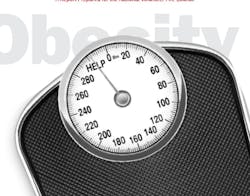Study: Obesity Rate for Firefighters Higher Than Public
Daily, there are accounts about the ever-increasing waistlines of U.S. citizens.
A study released Monday shows firefighters have higher rates of obesity than the general public.
Authors of "Addressing the Epidemic of Obesity in the United States Fire Service" wrote: "the number of individuals who are overweight, obese, and unfit has risen to alarming levels in fire departments, both volunteer and career, across our nation."
The National Volunteer Fire Council received a FIRE Act grant to help fund the study conducted by HOPE Health Research Institute.
Heart attacks have been the top killer of fire and rescue personnel across the nation for many years.
Among the key findings of the study include: * Rates of overweight and obese individuals in the fire service are higher than those found in the general public, ranging from 73 percent to 88 percent of firefighters.
* The high rates of obesity in the fire service do not appear to be due to inaccuracy in measurement.
* Research demonstrates that a large percentage of firefighters do not meet minimal standards of physical fitness.
* Occupational factors may place firefighters at high risk for weight gain, including shift work, sleep disruption, unhealthy eating patterns in the firehouse, and the absence of fitness standards for firefighters.
* Overweight and obese firefighters have been shown to suffer from a large number of problems compared to their colleagues, including hypertension, higher risks for cardiovascular disease, low fitness, reduced muscular strength, and more frequent cardiac events.
* Overweight and obese firefighters are less fit to perform their jobs and cost fire departments significantly more than firefighters with a healthy weight.
"The authors are well-versed in the subject matter and have conducted nutrition and fitness research for over two decades, including the largest studies of obesity, physical activity, and nutrition in the fire service conducted to date," the document states.
Researchers also delved into reasons for the expanding waistlines. They include:
*The nutrition environment in many firehouses appears to reinforce poor eating habits and unhealthy nutrition.
* Attempts to improve nutrition in the firehouse often are met with resistance.
* Firefighters often consume diets high in processed carbohydrates and sugar, which promote obesity and cardiovascular disease.
*Diets that keep insulin levels stable and focus on foods with a low glycemic index promote a healthy body composition and improved performance.
* Firefighters overestimate the ability of physical activity to counteract the impact of large food portions or unhealthy dietary choices.
They also offer recommendations on how to get healthy including eating and exercise tips.
"This report will urge everyone from national fire service leadership, to department chiefs, to individual firefighters to think creatively and join in efforts to reverse the negative trends of unhealthy body weight and poor physical fitness. It is time to begin a national conversation regarding obesity in the fire service," the authors wrote.
"This report provides basic data which can be used to educate yourself and your colleagues about the epidemic and provides suggestions you can use to address fitness in your department."
